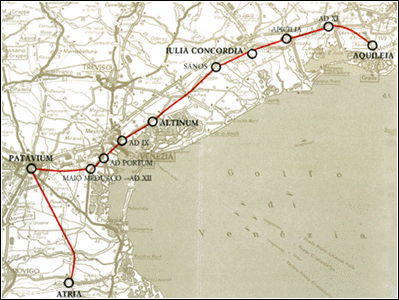
It’s a well-known fact that the Romans were great road builders – roads which fortified and enriched towns already in existence, and roads which caused new towns to be established.
Above all, they were the means through which Roman civilisation, including trade, language, art plus an administrative and judicial system were diffused.
The Veneto was linked to the Roman world by two great consular roads: Via Postumia (the Postumia Way) built in 148 b. C. which linked Genoa and Aquileia, and Via Annia constructed in 731 b. C. by the praetor Titus Annius Rufus which starting to Adria ran along the Adriatic coast as far as Aquileia. With the help of aerial photos and some documentation, the general outline of the road can be traced. Between the Padua–Altino stretch of the Via Annia were two known stopping points where refreshment for both men and horses was provided. In addition , there were stables, washrooms and workshops. These places could be reached by following a route on the right of the Brenta river, according to some experts while others affirm that the road went along the left bank, meaning that these stopping places must have been in Dolo and Mestre. This discrepancy has come about because of the varying distances registered between Padua and Altino along the ancient route. Along the Annia, between Padua and Altino four milestones have been found. These are low circular column – shaped stones mostly set up by emperors who, even long after the road had beeen built, kept it in a good state of repair. Usually the distances betweeen two places were recorded on these stones. They have also been found at Stanga in the Padua suburbs, San Bruson, Campalto and in Quarto D’Altino.
The stretch of roads between Porto Menai and Altino and then further south of Musile, was built on raised land because the surrounding area was subject to flooding. Owing to the difficult, ever–changing hydrographic situation on this coast, the road ran island and required frequent maintenance work because of flooding from the marshes. Many emperors and their armies travelled along this route in the 6th century A. D. to defend the eastern boundary of the Empire. Their names were recorded on five milestones found along the Musile di Piave–Ceggia stretch of road which continued running east and crossed an ancient branch of the Piave River on a three arched Roman bridge whose foundations can still be seen, very strong and well-built. The road continued south of Ceggia. Here there are two piers and some three arched bridge-heads constructed with sandstone stabs which crossed a now non-existent part of the river known as Canalat or Old Piavon. Then the river reached Livenza and crossed the river at Santa Anastasia over a bridge whose remains have been visible since the last century. Here the road then went north-east towards Concordia . Julia Concordia, today known as Concordia Sagittaria, was a famous Roman colony founded in 42 B. C. and fluorished even during the late empire period. This town must have been the largest Early Christian settlement in the Veneto after Aquileia, a hypothesis backed up by the enormous quantity of remains and objects which have been found.